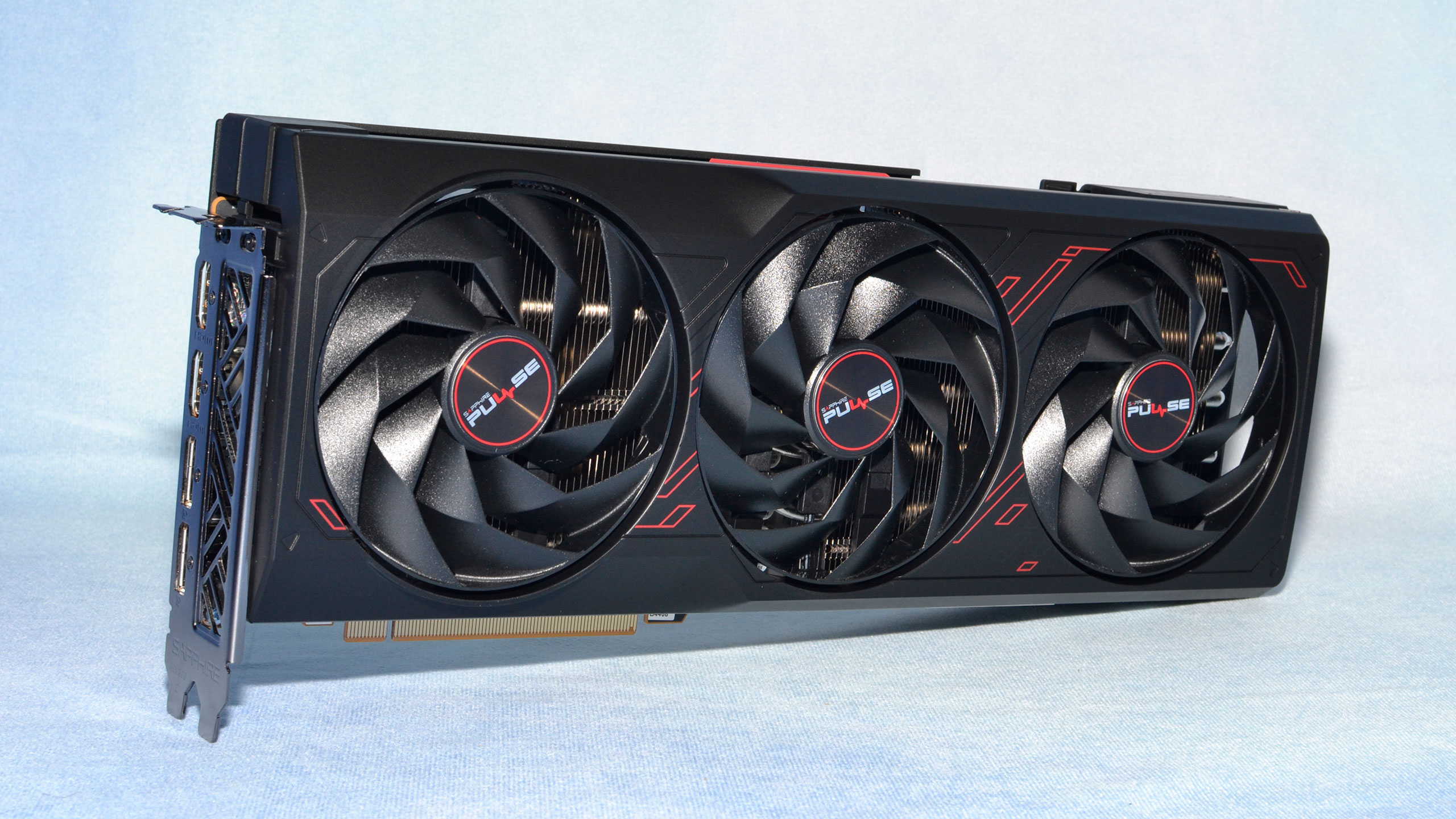Why you can trust Tom's Hardware
The 1080p testing results aren't quite as important on a $549 graphics card, though native 1080p does work as a pseudo stand-in for how the various games might run with upscaling enabled (minus a bit of performance due to upscaling overhead). We have both ultra and medium quality results, in that order, in the chart galleries below.
AMD RX 7900 GRE 1080p Overall Performance


The RX 7900 GRE falls slightly behind the RTX 4070 in our overall metric at 1080p. They're still basically tied, but AMD's GPU tends to pull ahead once there's more of a strain on raw memory bandwidth thanks to its having more VRAM and a 256-bit interface. The 4070 ends up 1.3% faster at ultra settings and 2.7% faster at medium settings.
AMD's 7900 GRE also loses a bit of its advantage over the 7800 XT at 1080p. Now it's 8.4% faster at ultra, and only 6.5% faster at medium settings. That's partly because CPU bottlenecks start to come into play on several of the games. The same is true for the 7900 XT, as its lead shrinks to 14% at ultra and just 9% at medium compared to the 7900 GRE.
AMD RX 7900 GRE 1080p Rasterization Performance



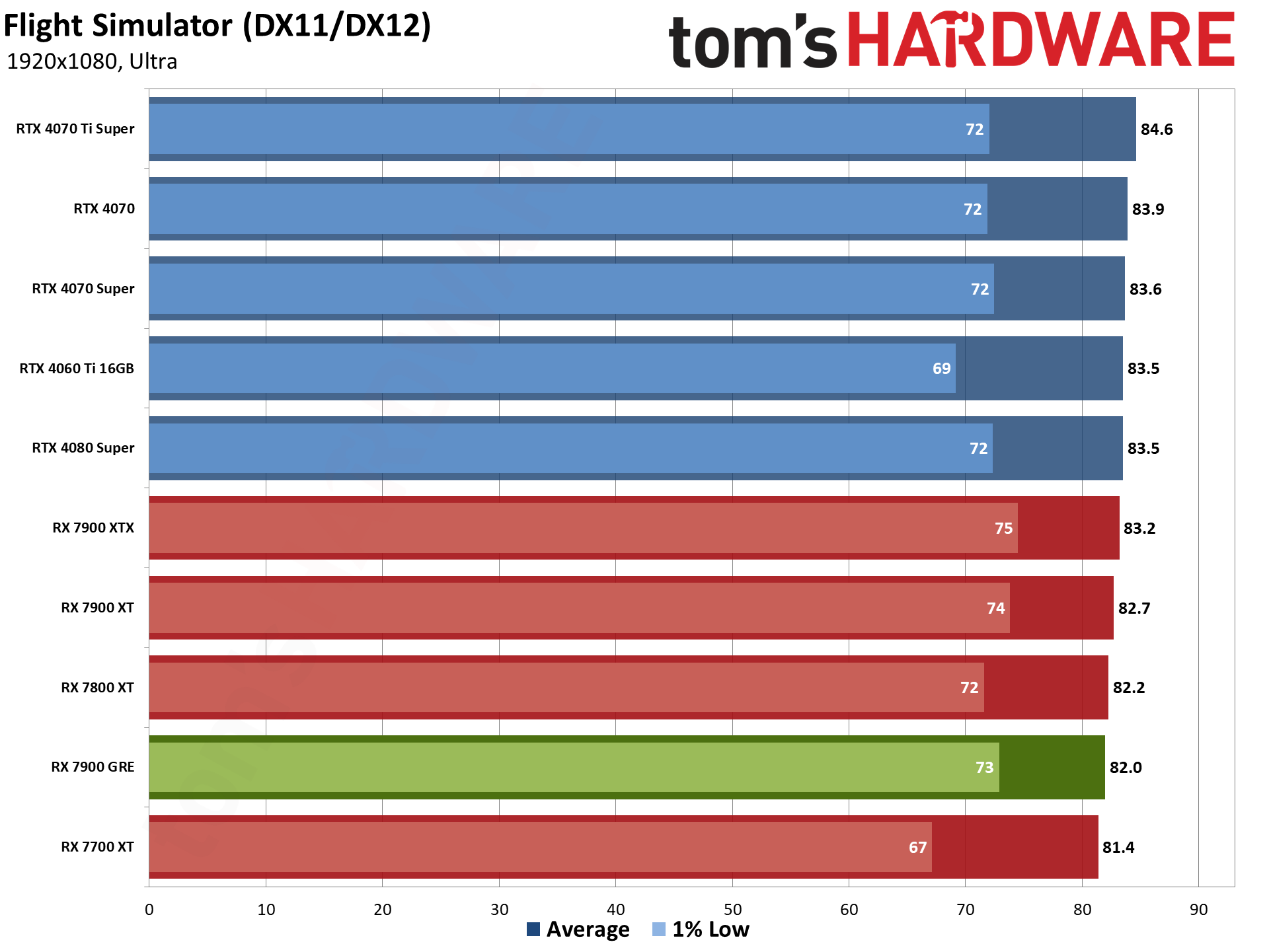
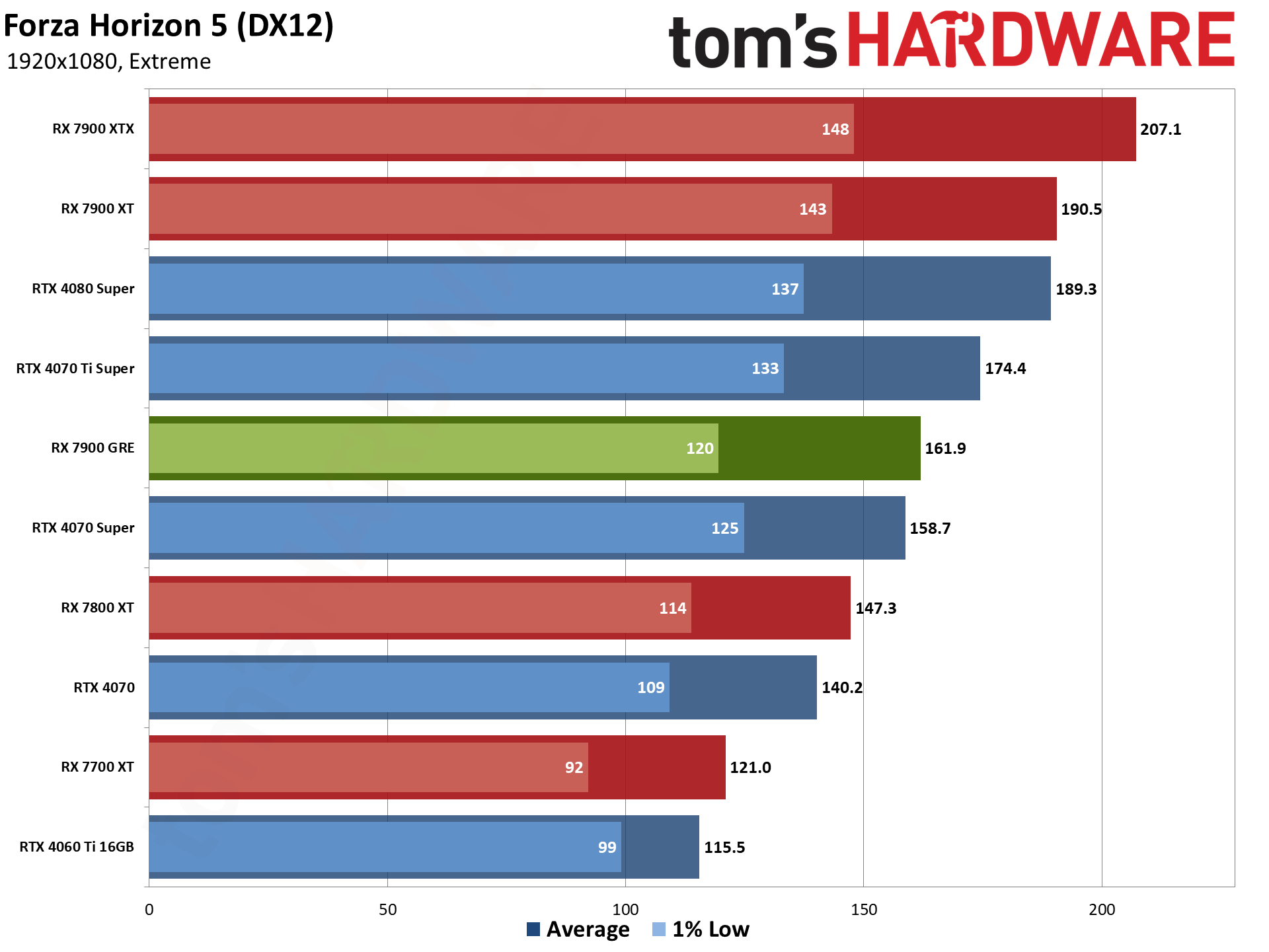
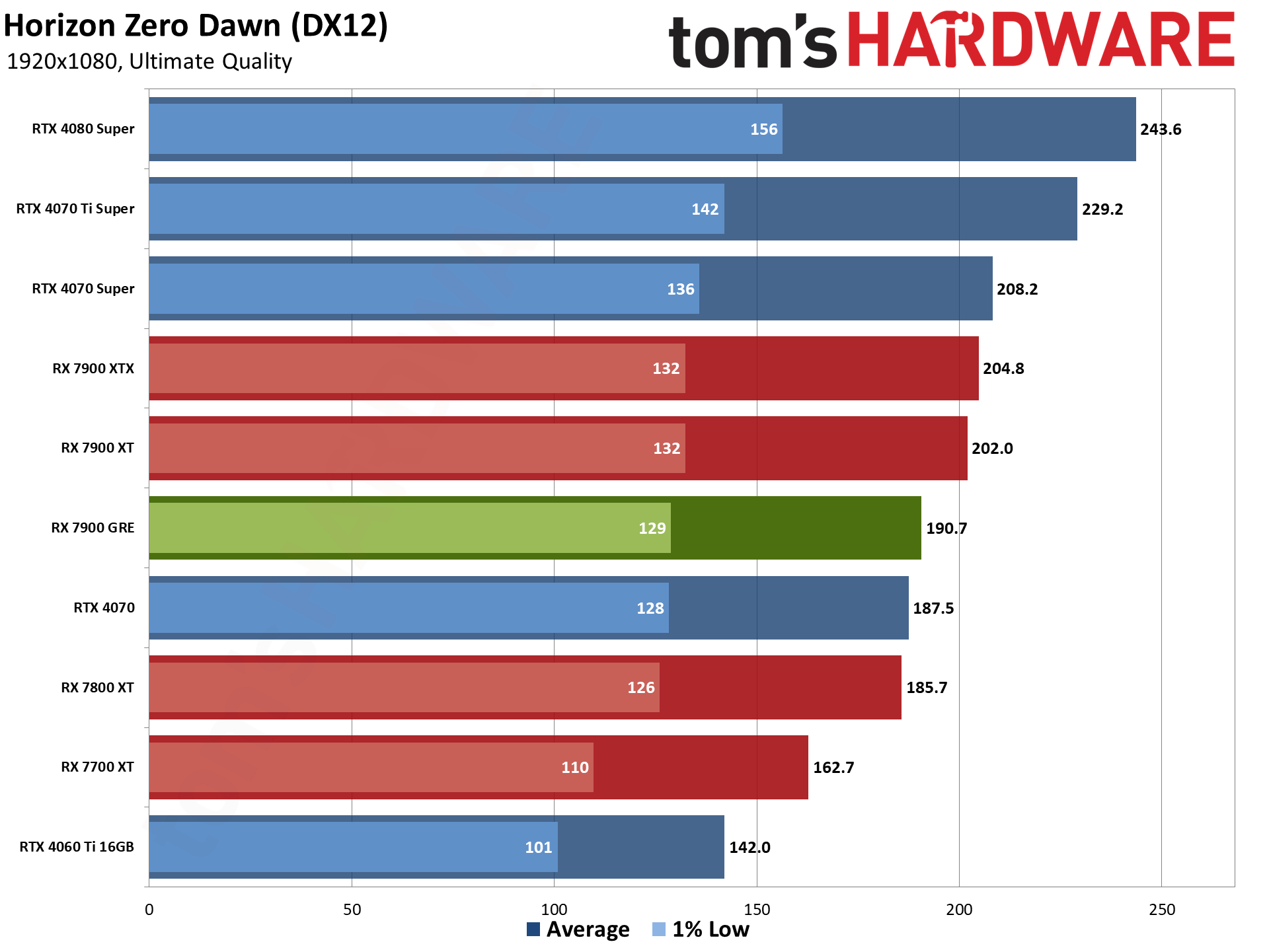
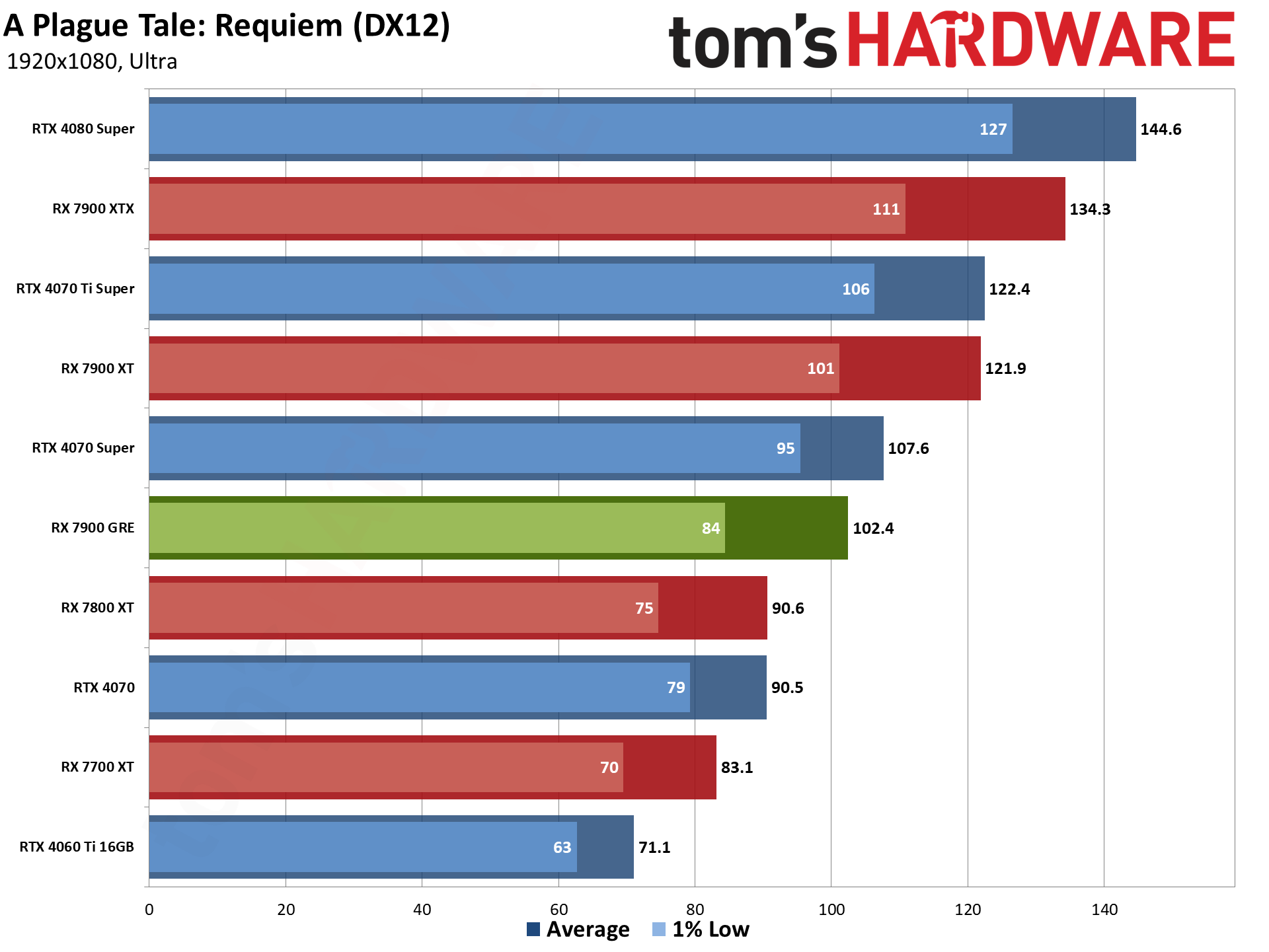
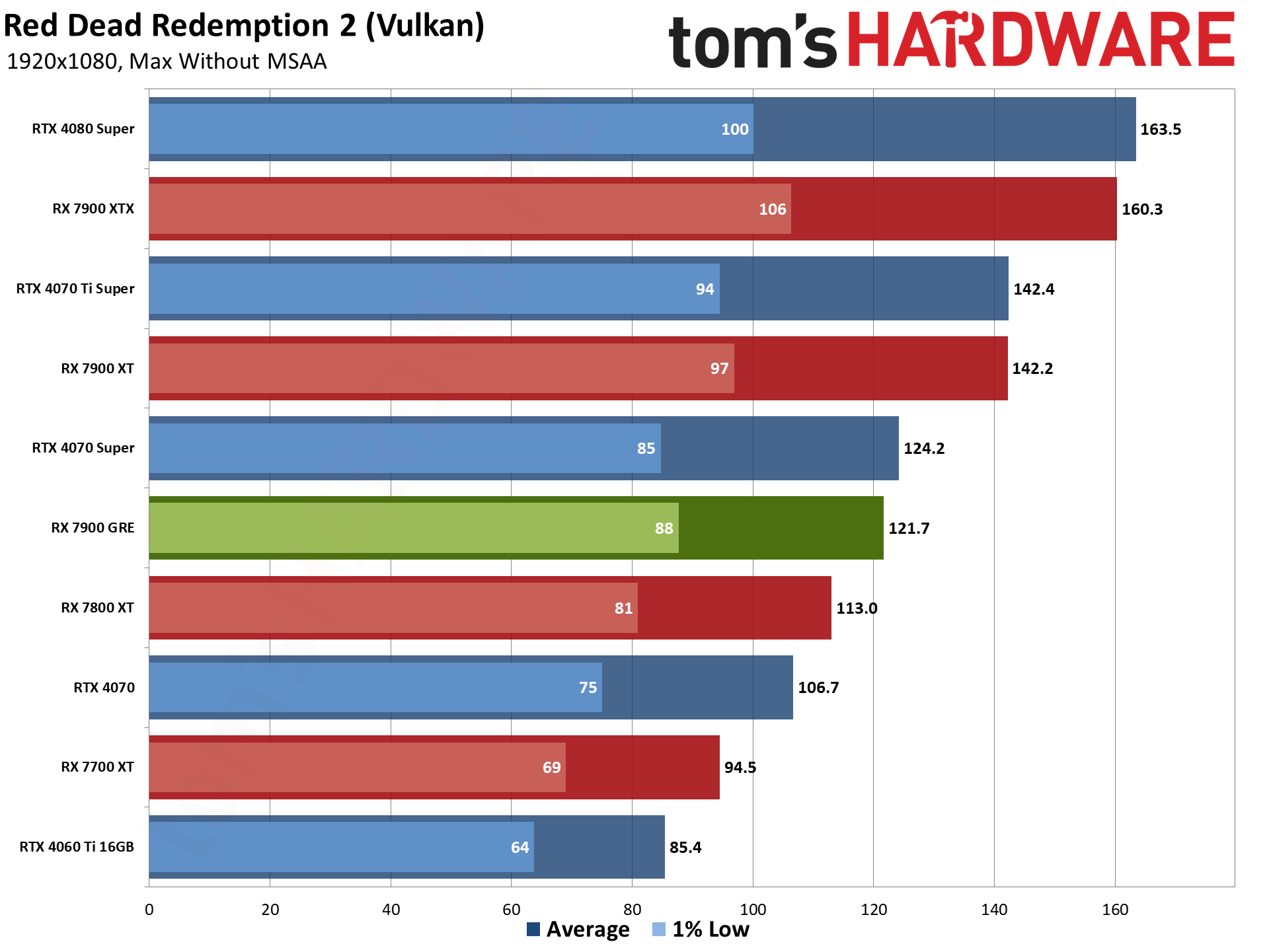
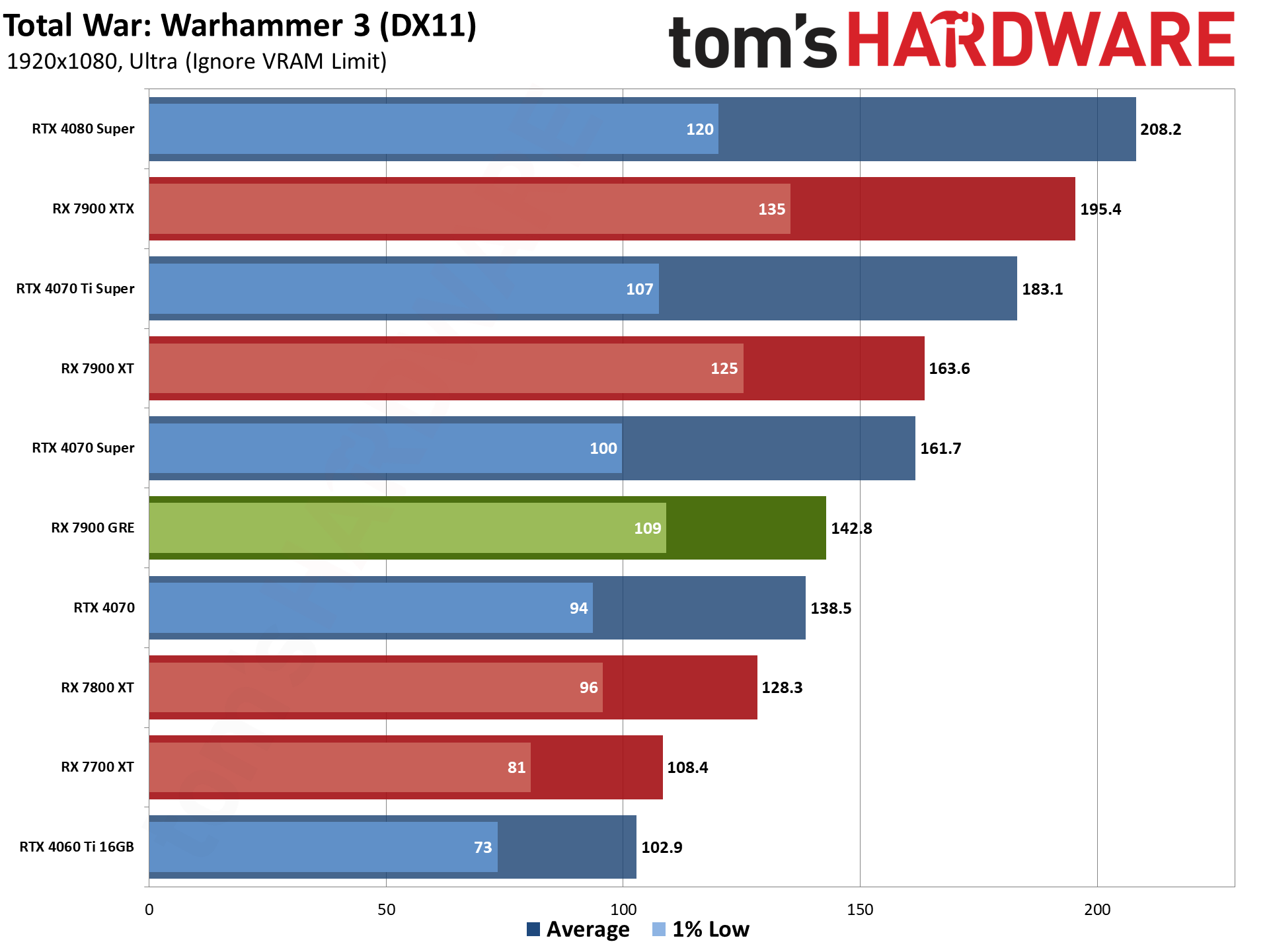
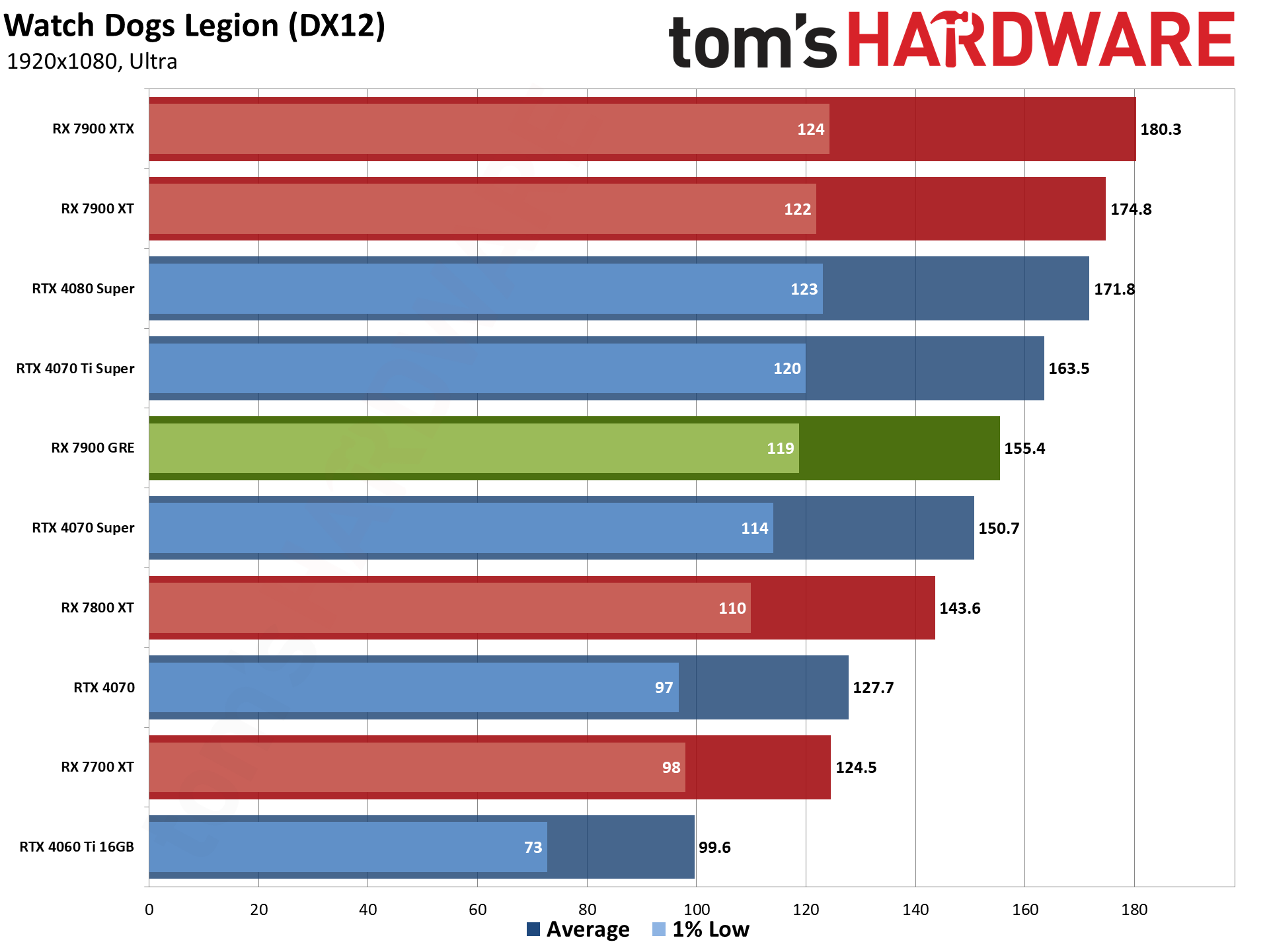

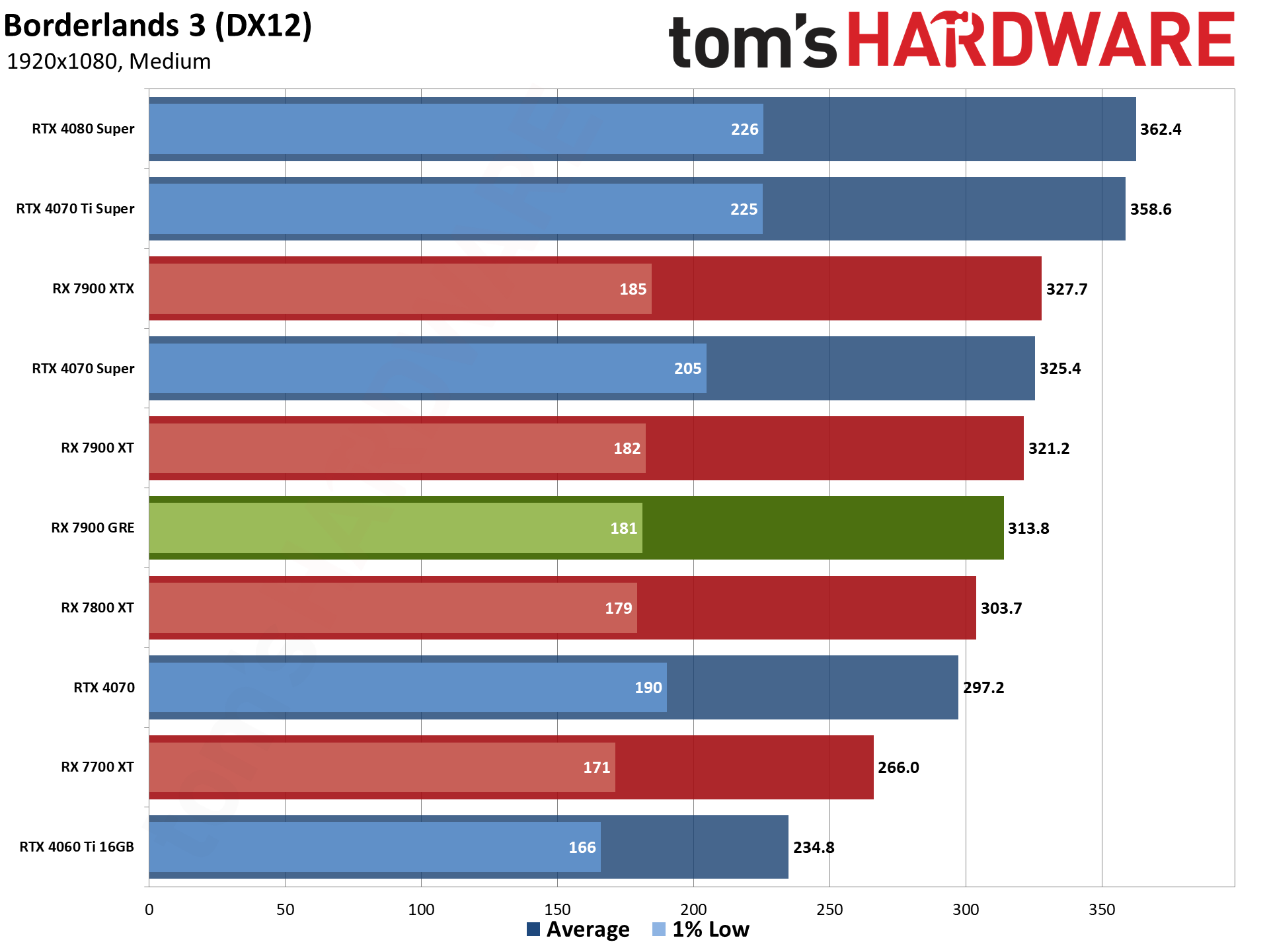
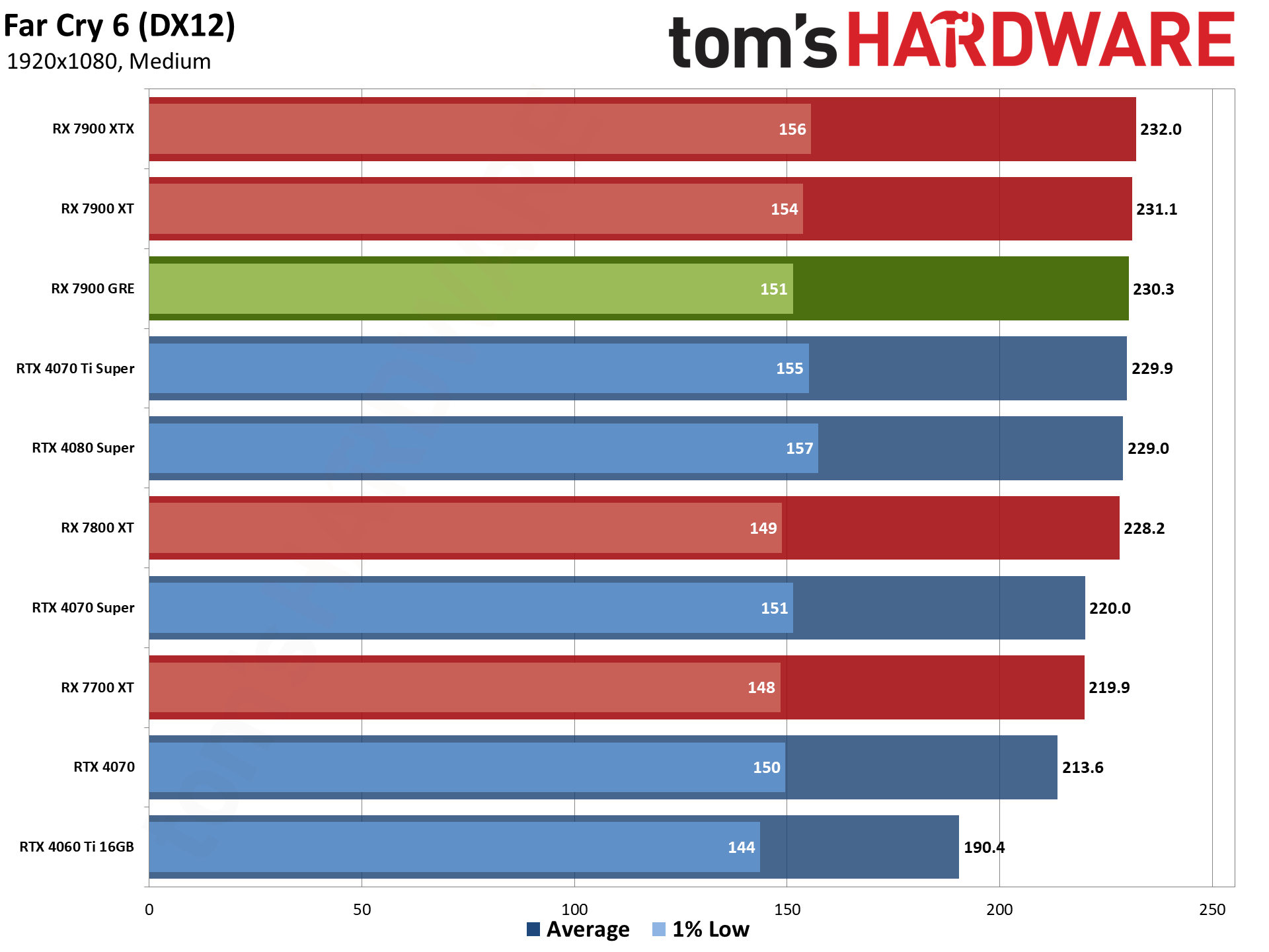


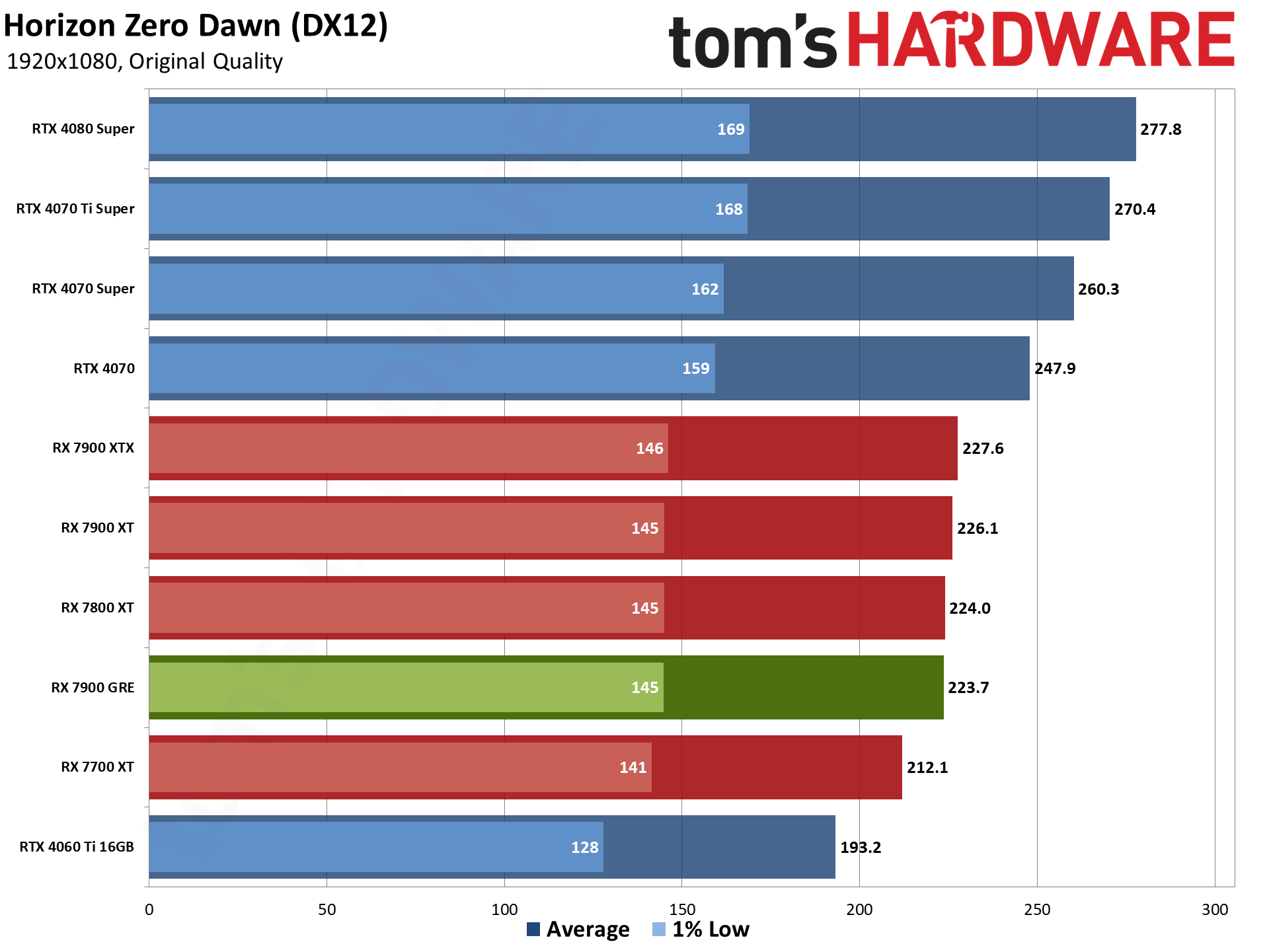
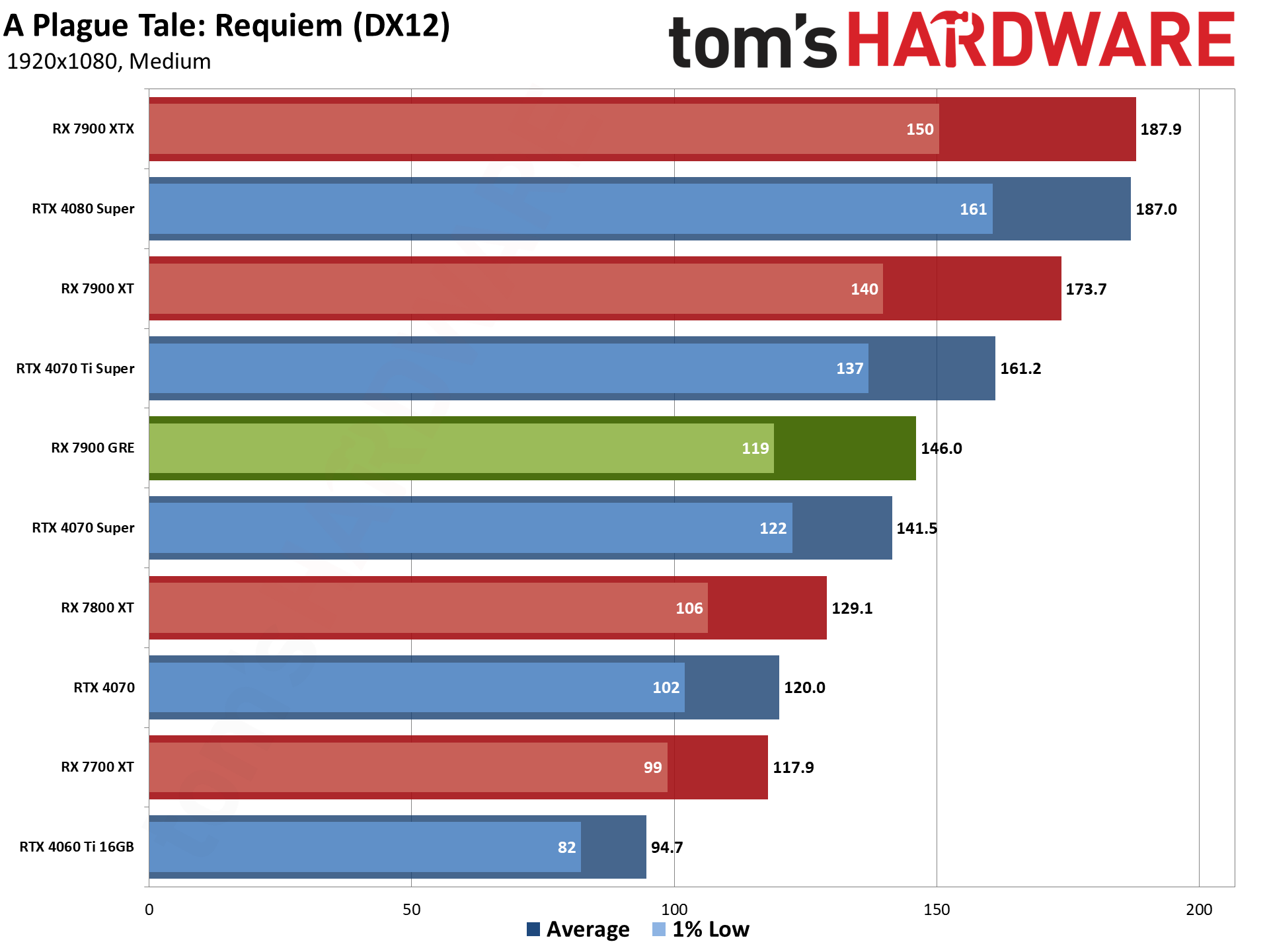

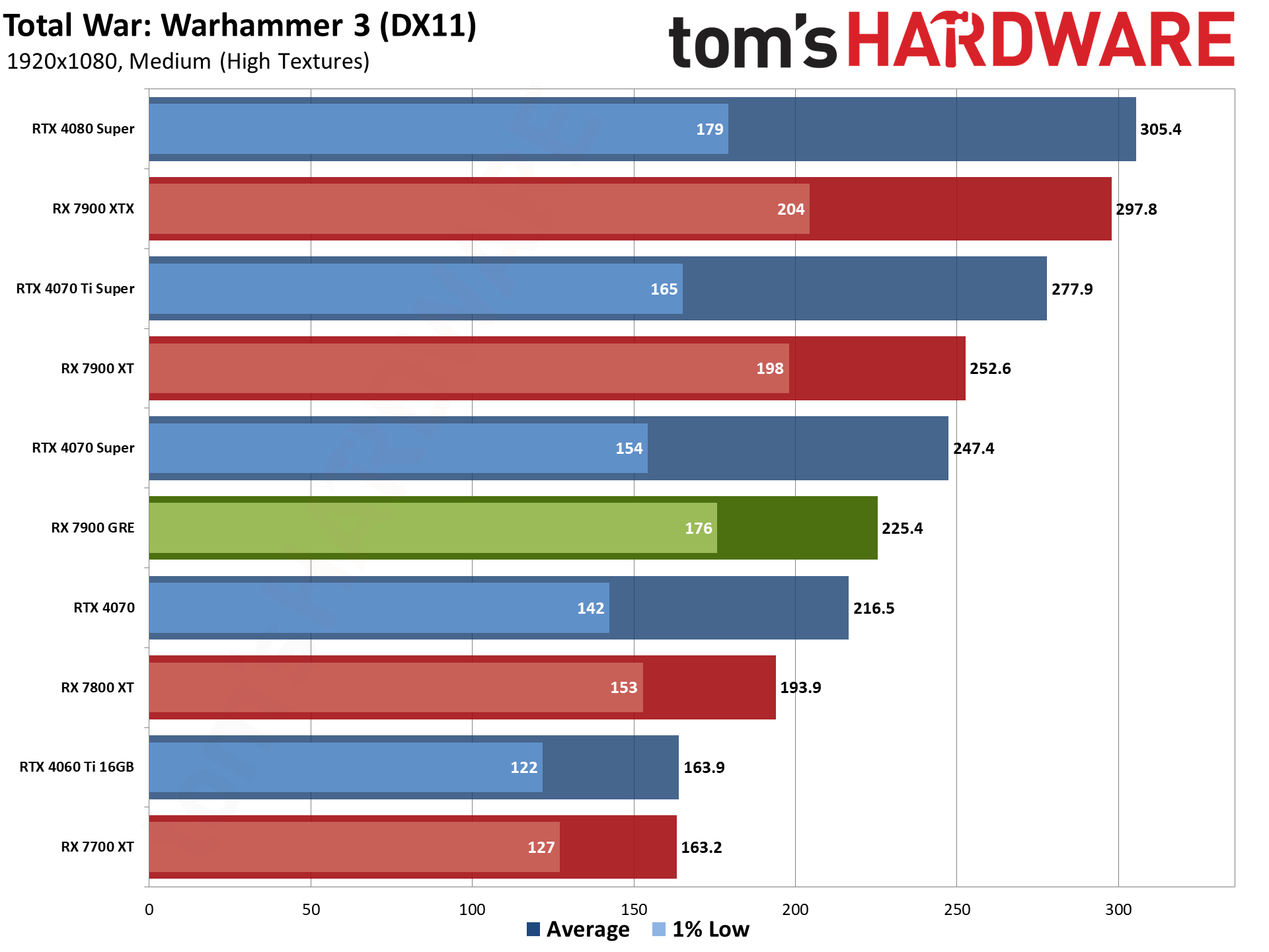

There are a lot of charts in the above gallery of rasterization results, though the two overall charts are most meaningful in determining how the 7900 GRE stacks up. It leads the RTX 4070 in rasterization performance, but the margins are smaller at 1080p: 11% at ultra settings, and 6% at medium settings. The 4070 Super meanwhile comes in 1.5% ahead of the 7900 GRE at both ultra and medium settings.
Overall, the 7900 GRE averages 144 fps at ultra settings, with Flight Simulator being the only game that fails to break 100 fps — that's a CPU bottleneck, where ultra settings on the 13900K result in a performance limit of around 80~84 fps in our test sequence. Far Cry 6, Horizon Zero Dawn, and Watch Dogs Legion are all bumping into CPU limits as well on the RX 7800 XT and above.
AMD RX 7900 GRE 1080p Ray Tracing Performance


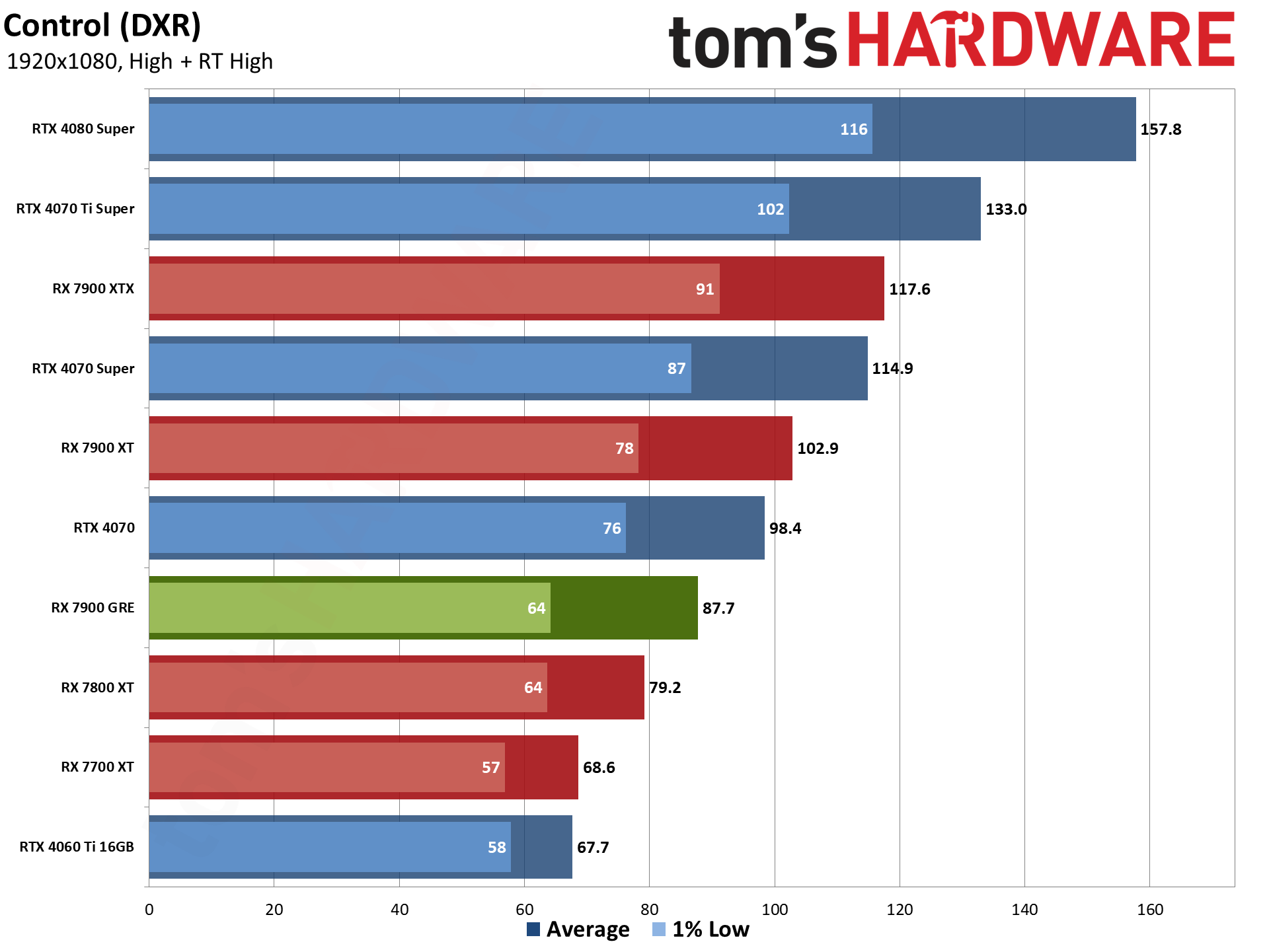

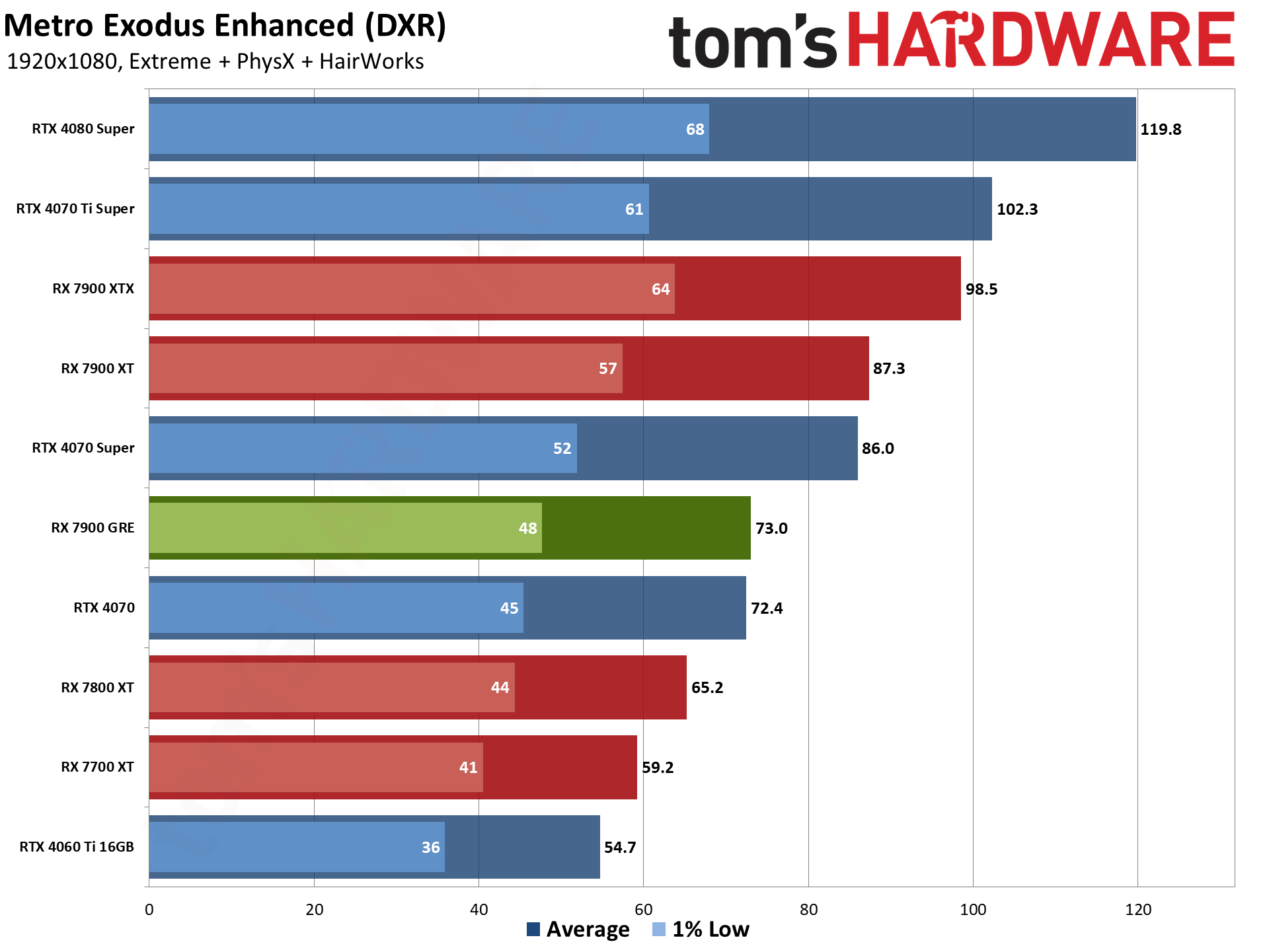


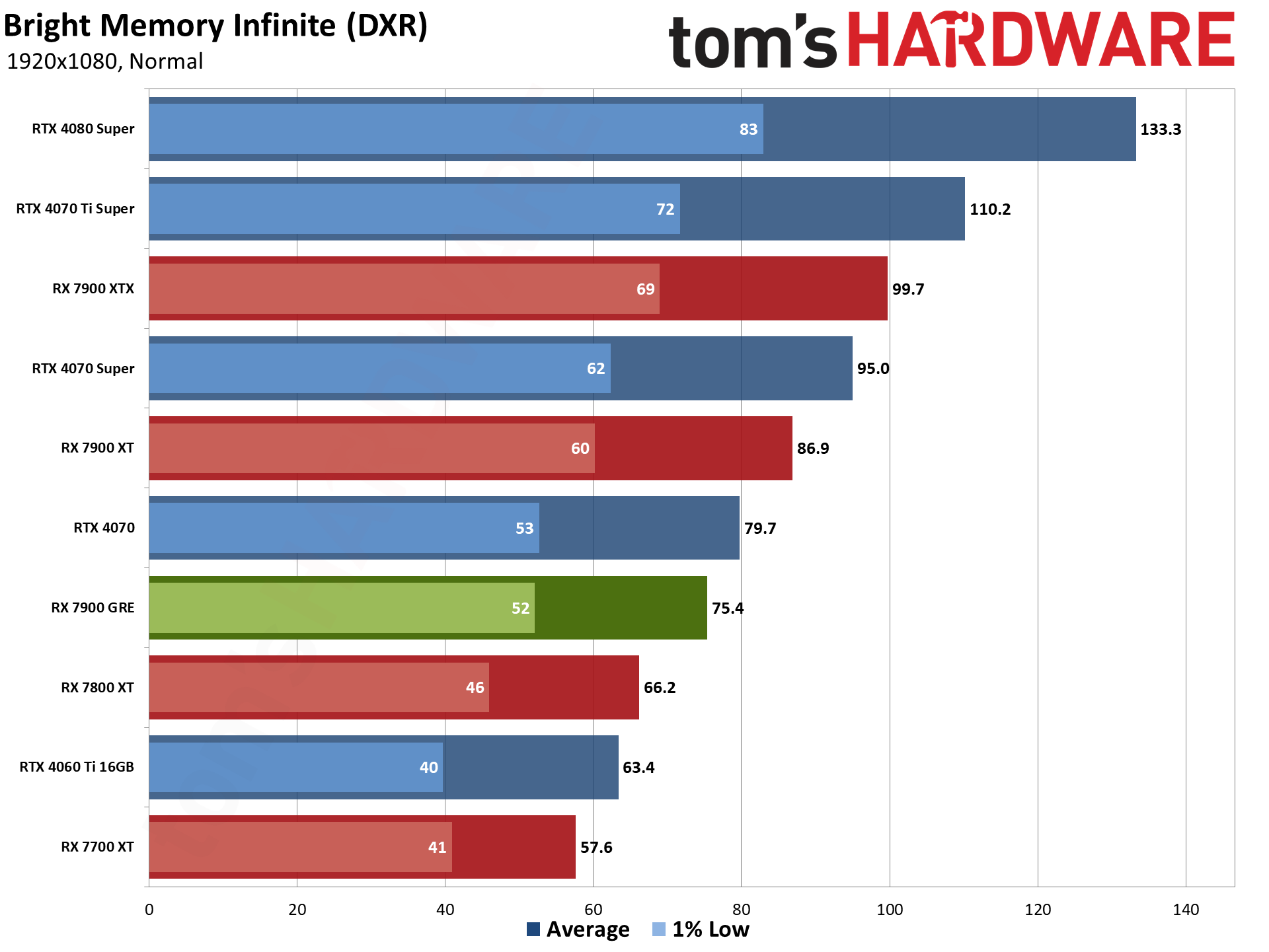
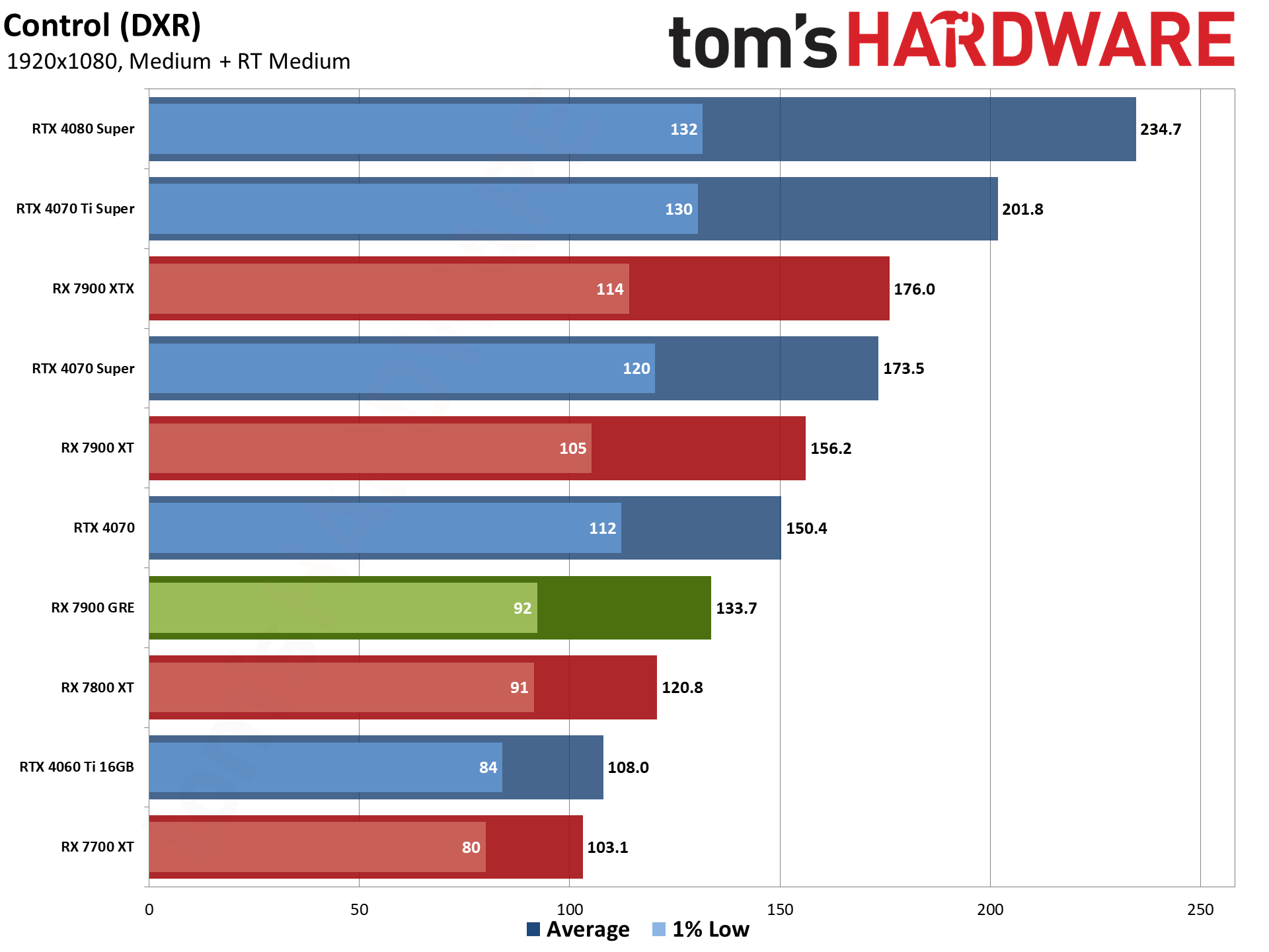


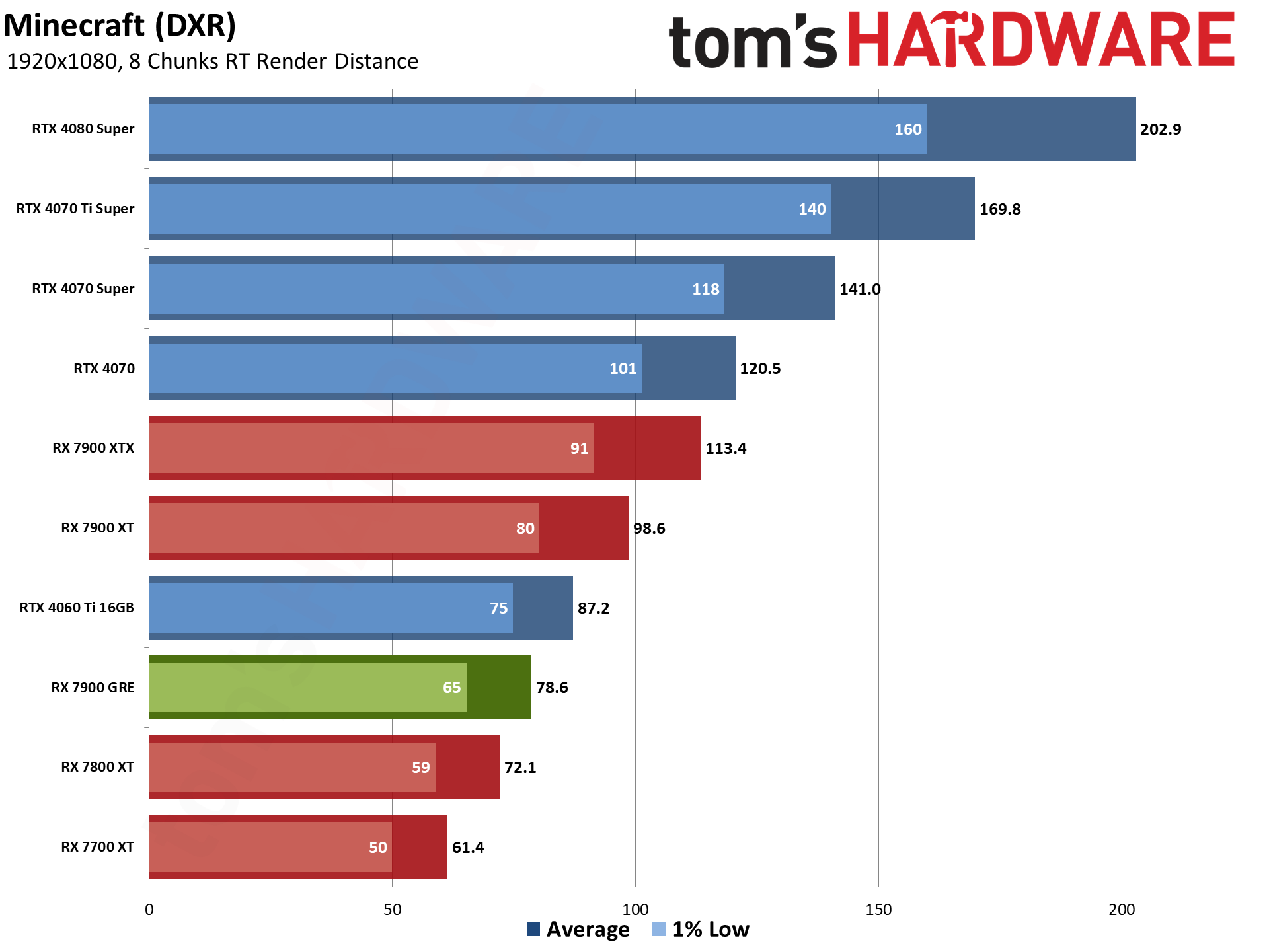
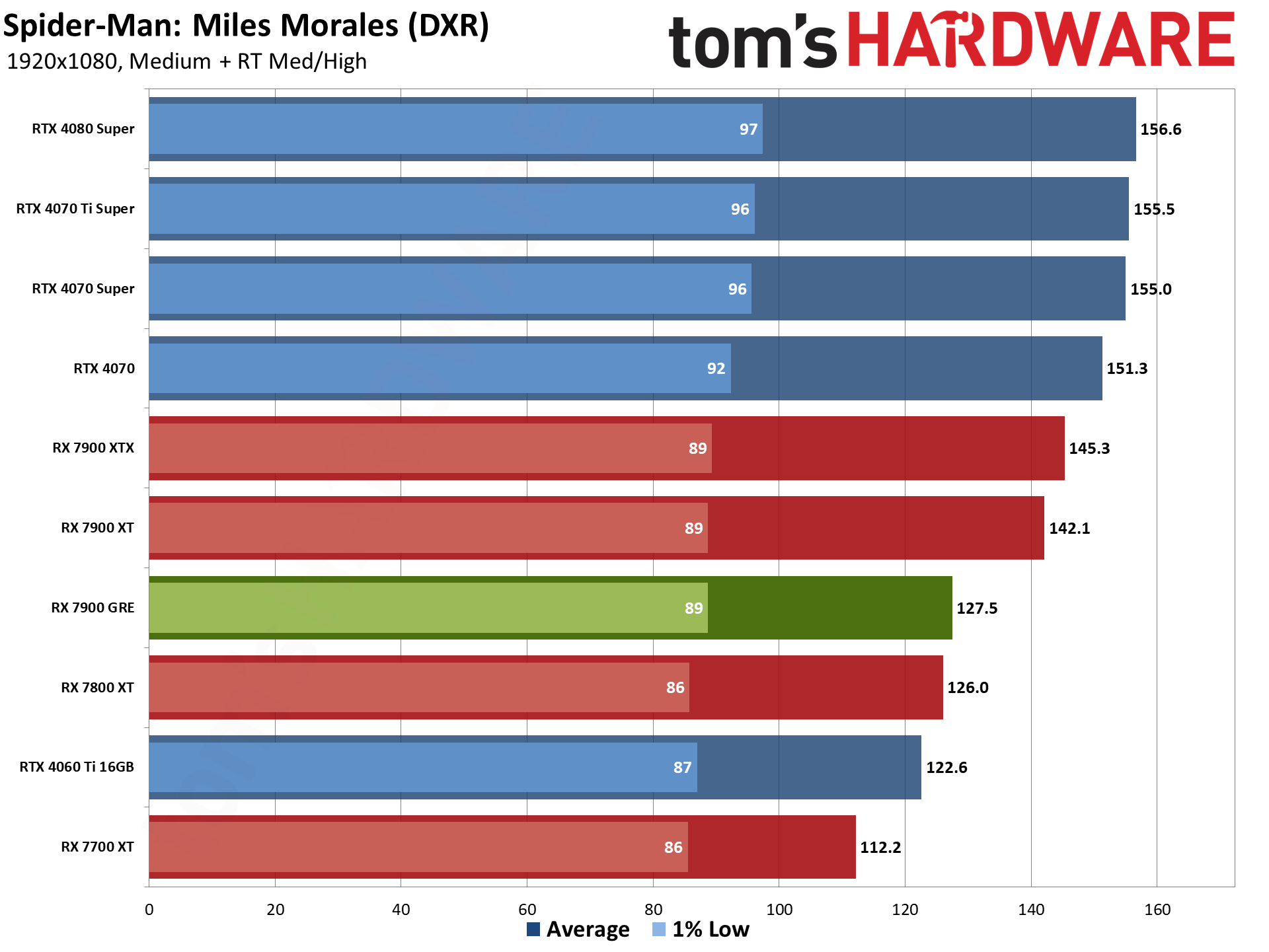
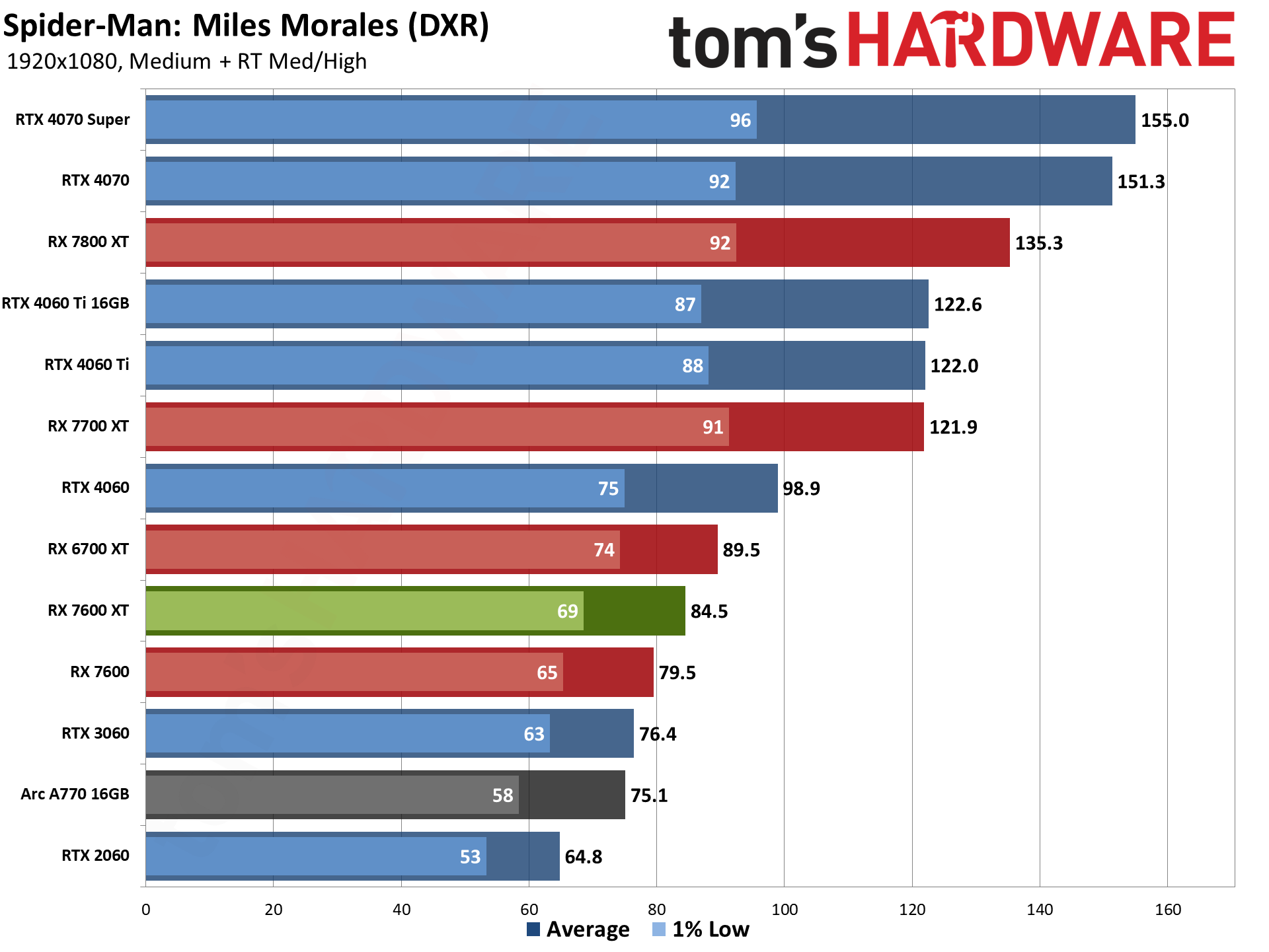
For the ray tracing tests, 1080p makes things more viable on AMD GPUs, and the 7900 GRE averages 69 fps overall at ultra settings, and 99 fps at medium settings. Of course, medium settings with ray tracing doesn't make much sense — downgrading image quality in some ways while taking the performance hit from ray tracing.
One thing about ray tracing games is that compute resources tend to be a bigger factor, while memory bandwidth can at times be less critical. Even with less bandwidth, the 7900 GRE beats the 7800 XT by 10% at both our medium and ultra settings for 1080p DXR testing.
And as expected, the RTX 4070 takes the win over the 7900 GRE in this case: 17% faster at medium settings and 22% faster at ultra settings. The only DXR game in our test suite where the 7900 GRE is able to match the RTX 4070 is Metro Exodus Enhanced, where it's 5% faster at medium settings and also had more consistent minimum fps. In the other five games, the 4070 leads by anywhere from 6% (Bright Memory Infinite) to 60% (Minecraft, of course).
AMD RX 7900 GRE 1080p Bonus Games
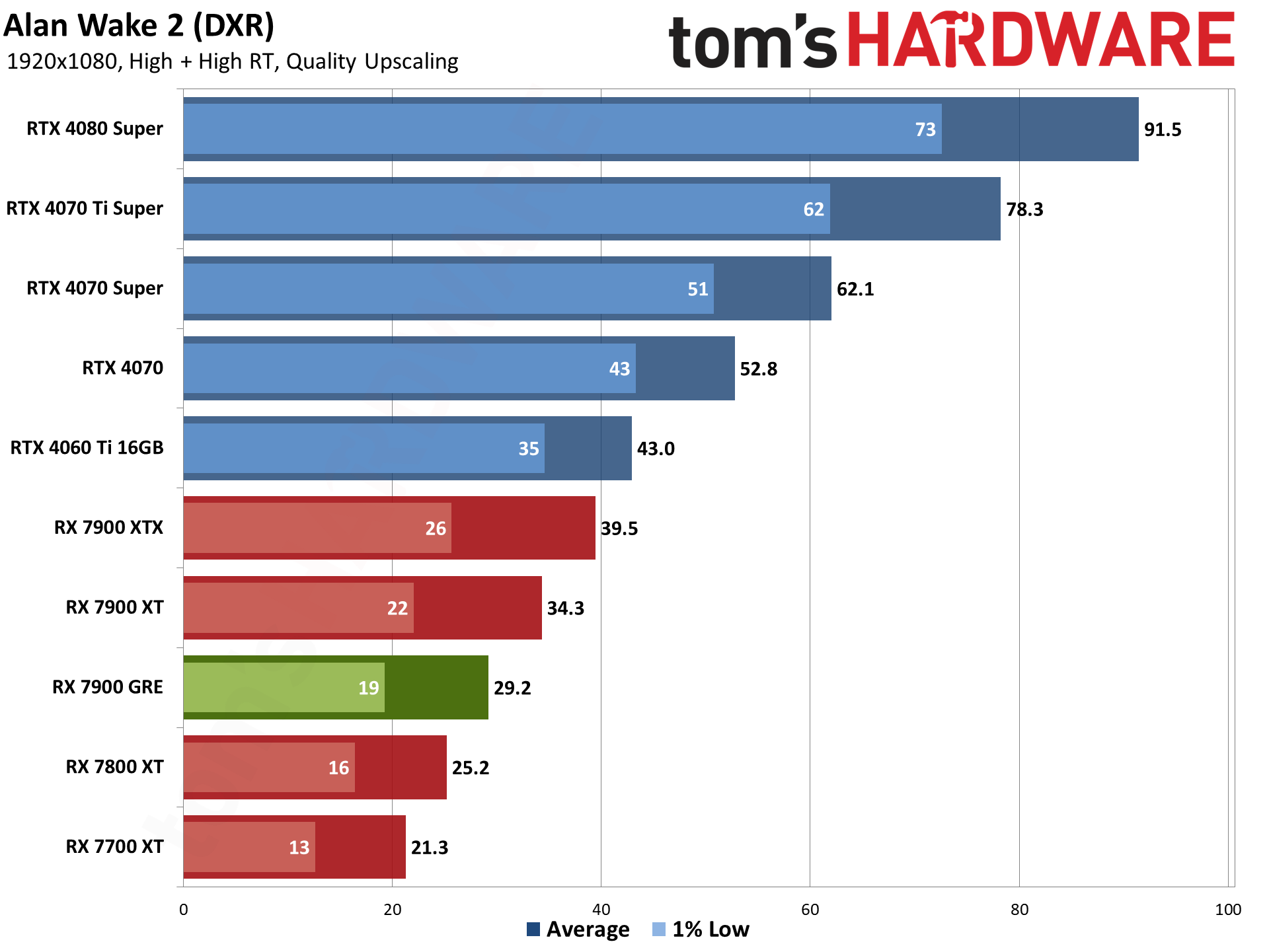

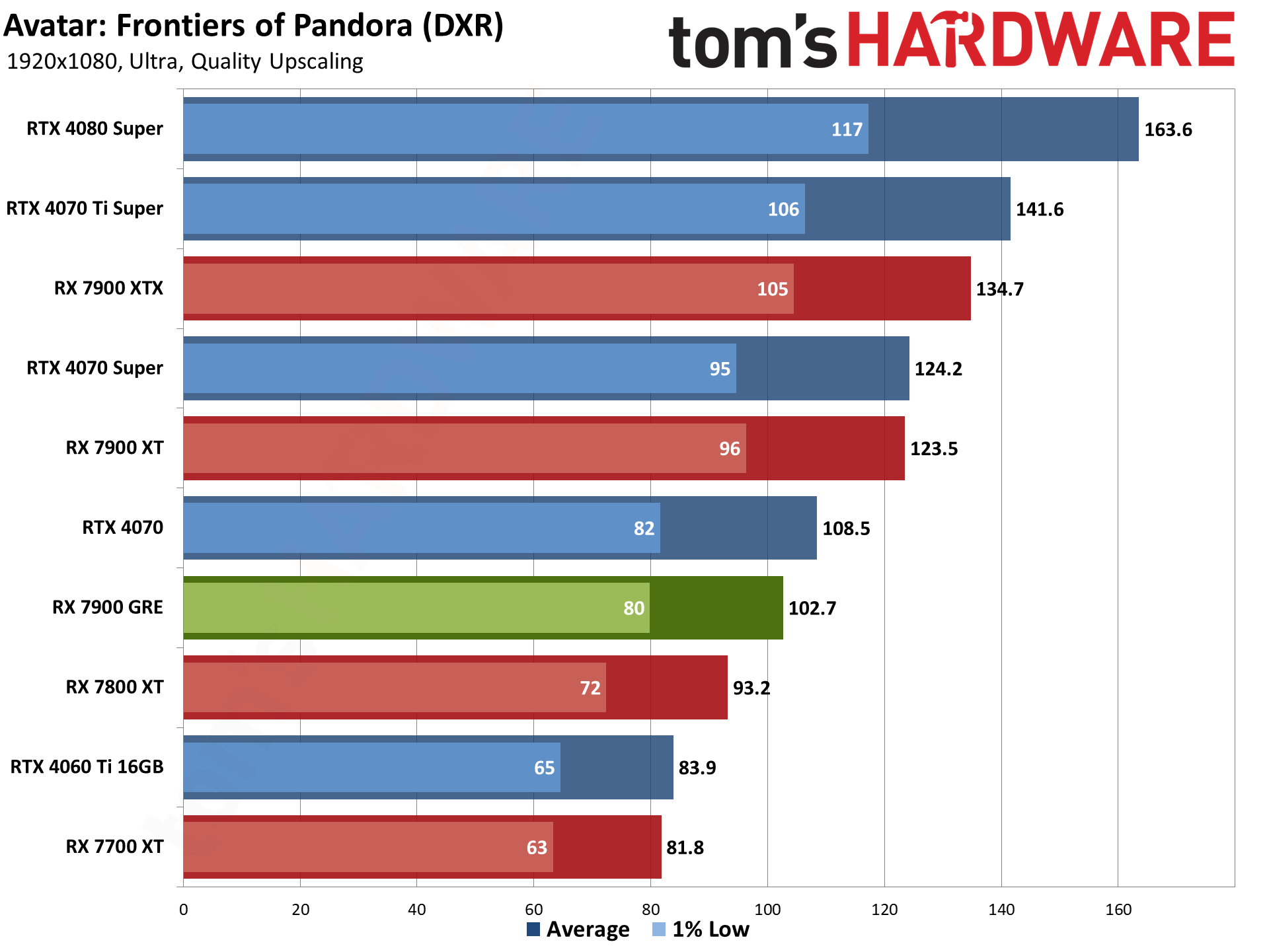

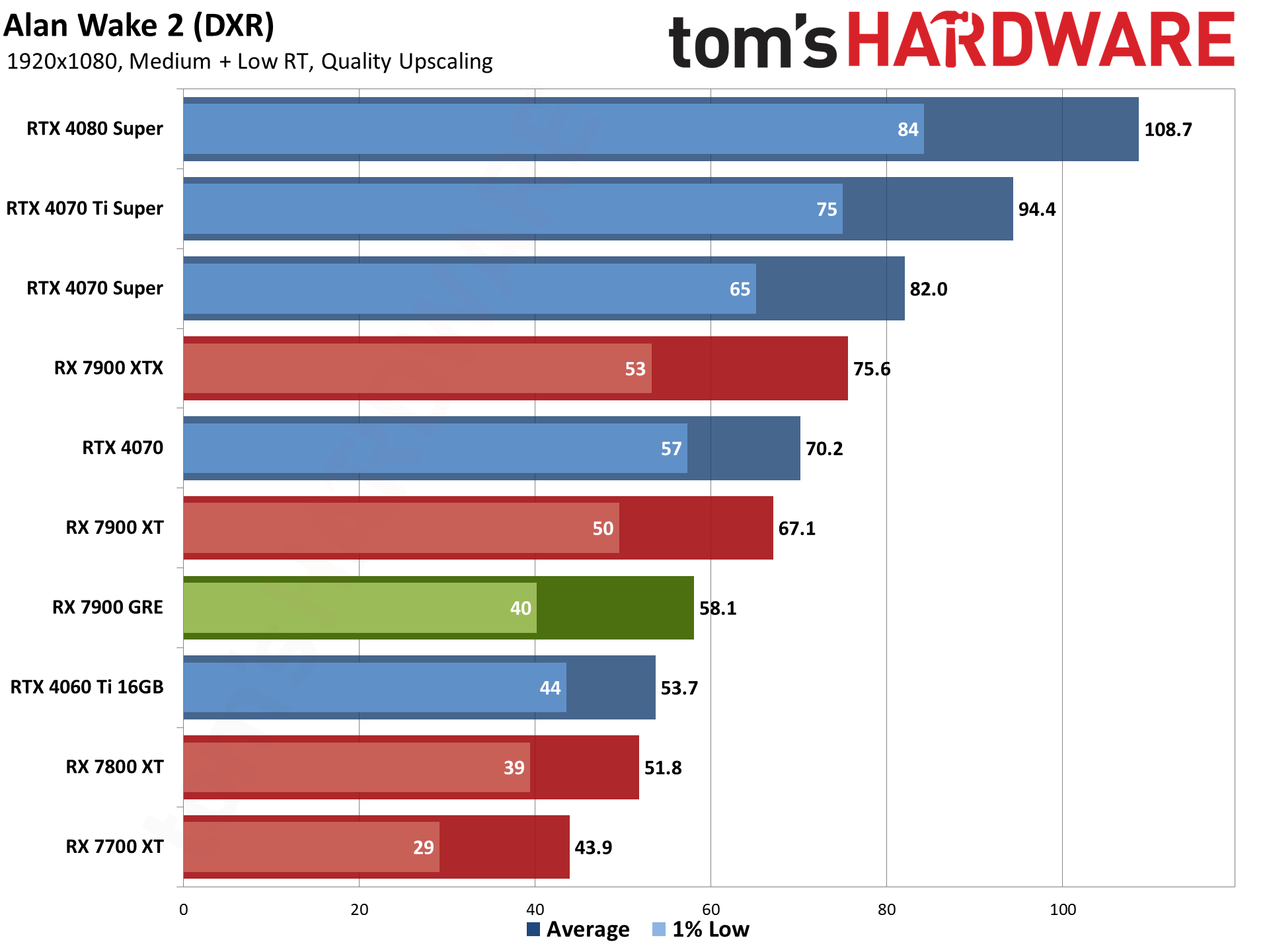
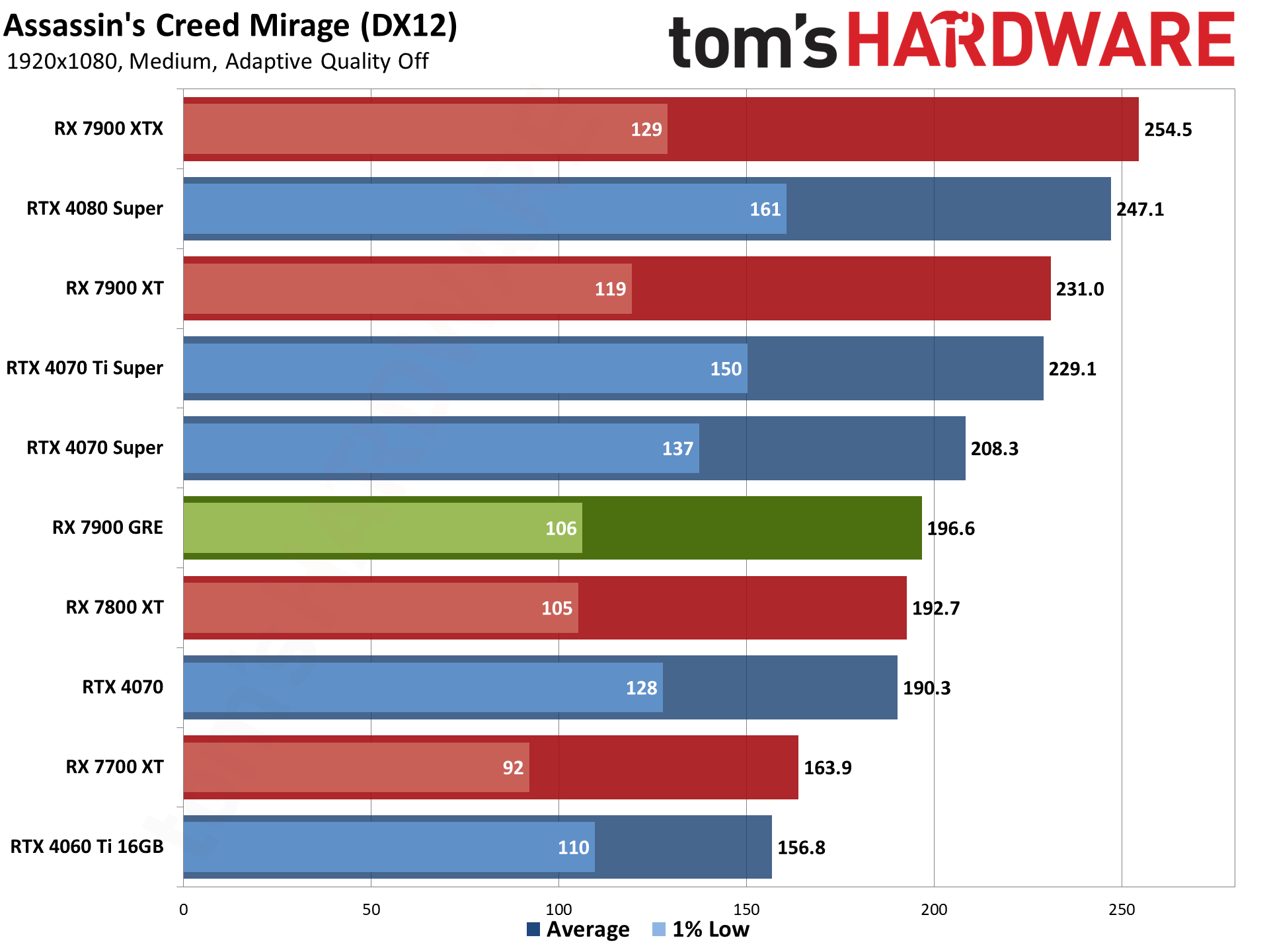
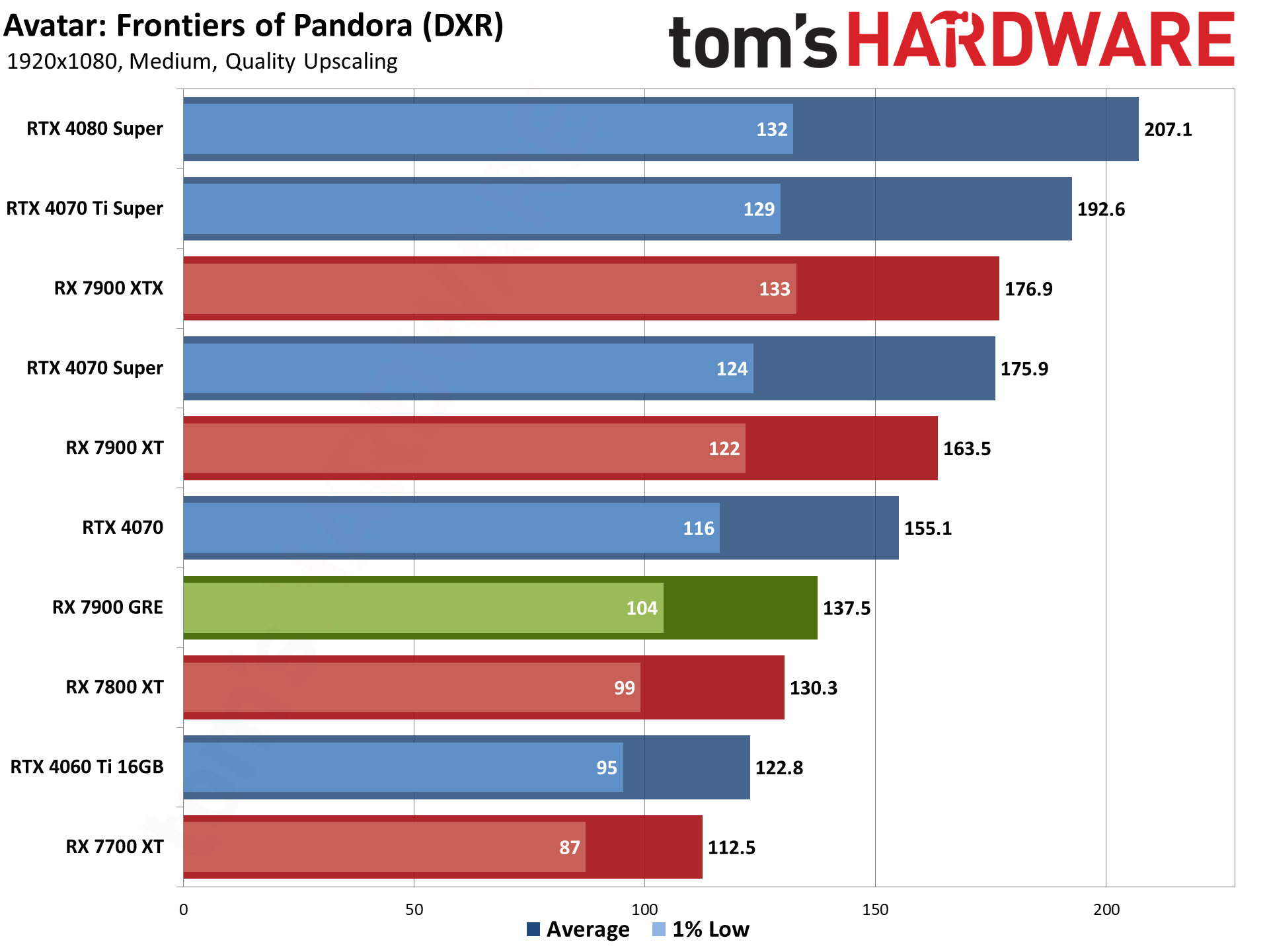

Alan Wake 2 with our 'medium' settings proves to be much easier to run than the 'ultra' settings that use path tracing — and of course upscaling helps. The 7900 GRE manages a very playable 58 fps. That plummets to 29 fps with path tracing enabled. The competing RTX 4070 on the other hand gets 70 fps at our medium settings and only drops to 53 fps with path tracing — and DLSS 3.5 Ray Reconstruction also makes it look clearer and better in either case.
The 7900 GRE and RTX 4070 are pretty closely matched in Assassin's Creed Mirage, with AMD's card leading by just three percent at 1080p. And as we've seen elsewhere, it only has a slight lead over the 7800 XT as well. Based on the results, we'd venture to guess that Assassin's Creed Mirage likes more memory bandwidth.
Avatar again favors the RTX 4070 over the 7900 GRE, with Nvidia leading by 6% at ultra settings and 12% at medium settings. Perhaps due to the use of ray tracing effects, it also seems to depend more on compute than memory bandwidth, so the GRE beats the 7800 XT by 10% at ultra settings — but that drops to just 6% at medium.
The Last of Us still favors the GRE by a large margin over the 4070 as well, though this time it's 'only' 17% at ultra settings and 15% at medium. The 7800 XT matches the GRE as well at medium settings, where CPU bottlenecks are coming into play, though the GRE still has a 5% lead at 1080p ultra.
- MORE: Best Graphics Cards
- MORE: GPU Benchmarks and Hierarchy
- MORE: All Graphics Content
Get Tom's Hardware's best news and in-depth reviews, straight to your inbox.
Current page: AMD RX 7900 GRE: 1080p Gaming Performance
Prev Page AMD RX 7900 GRE: 1440p Gaming Performance Next Page AMD RX 7900 GRE: 4K Gaming Performance
Jarred Walton is a senior editor at Tom's Hardware focusing on everything GPU. He has been working as a tech journalist since 2004, writing for AnandTech, Maximum PC, and PC Gamer. From the first S3 Virge '3D decelerators' to today's GPUs, Jarred keeps up with all the latest graphics trends and is the one to ask about game performance.
-
Notton So it falls directly between a 7800XT and 7900XT, and should have been called the 7900.Reply
It looks really good as a 1440p card.
It's not that interesting, considering it's price tag.
I'll wait to see what the RTX 5000 and RX 8000 series brings to the table, unless my 1070Ti croaks first. -
Giroro I'm surprised they didn't completely rebrand the card for the west. More generally, I'm surprised they're releasing it in the west at all.Reply
10% more performance for 10% more money isn't exciting, it's pointless. If they feel the need to release a minor stop-gap card, then I think they won't be ready to release anything truly exciting anytime soon. Maybe the AI surge has made them go back to the drawing board with RDNA 4.
It's hard to explain, but In my mind, something about calling it "Golden Rabbit" severely devalues it. So I imagine they at least will never spell out that acronym. Gold isn't valuable or aspirational; it's always cheap, fake, and tacky.
Also, I don't associate rabbits with being fast - I associate them with the weak fluffy bunnies that keep tearing up my yard.
Calling it golden means its a knockoff. It makes me think the GPU is actually some ancient Radeon HD 7970 chip that somebody is fraudulently trying to pass off as a counterfeit RX 7900 on Temu for $80 - or that it might have a virus or set my computer on fire.
Maybe I just buy too much counterfeit garbage from overseas. -
UnforcedERROR The conversation at $550 right now is almost specifically 1440p raster, which the 7900 GRE performs handily in. At these prices, 16 GB vs 12 GB for the 4070 is the biggest argument in its favor. Neither card is competent in Ray Tracing at 1440p, and the price-to-performance difference isn't enough to argue much otherwise, so it's mostly about longevity.Reply
As others said, it's not terribly interesting, and it feels like a notably late arrival, but it's something I suppose. I still feel like the $500 - $700 segment of cards is wholly disappointing from both NVidia and AMD. -
ohio_buckeye So it’s basically similar performance to a 6900xt or a 6950xt it sounds like? I’m happy with my 6800xt for now that I got under $450 new. I’ll hold onto that a while.Reply -
AgentBirdnest Hmm... I don't find it particularly exciting, but I don't have anything to complain about either. AMD had to do something to counter Nvidia's 4070 Super (and non-Super price drop), and this does it.Reply
What I'm really excited about, is where the 7800XT goes from here. I don't imagine it's going to stay at $500. If it drops to $450, that would be an extremely compelling option, and probably the best value of this generation.
As always, props to Jarred for the fabulous review! : ) -
thestryker Seems like decent enough perf/$, but doesn't really bring anything new to the table as expected. Not needing a video card has been a great place to be this generation as we're just now seeing some decent values though still limited to >$400.Reply
Per TPU the VRAM is limited to 2316mhz which caps the potential memory bandwidth at ~593 GB/s. The power limits on the card are at least standard so if anyone wants to try their hand at getting higher boost clock it is possible. -
ingtar33 this is basically just going to fill in the hole the 6900xt left in the market when it's stock ran out, they are both priced about the same, both perform about the same.Reply
It's not bad. the performance difference from the 7800xt to the 7900xt was pretty big (as was the $$ difference), this will slide right in between them at the old 6900xt price. It's a solid buy i think. I mean as solid as today's prices get.
everything is still overpriced. -
JarredWaltonGPU Reply
I do wish AMD hadn't lowered the VRAM speed from 20 Gbps. That probably would have given it another ~5% in performance, which would have been good. Right now, it's between the 7800 XT and 7900 XT, but slightly closer to the former. It makes sense from a pricing perspective, but even a few percent more overall performance would have been nice.ingtar33 said:this is basically just going to fill in the hole the 6900xt left in the market when it's stock ran out, they are both priced about the same, both perform about the same.
It's not bad. the performance difference from the 7800xt to the 7900xt was pretty big (as was the $$ difference), this will slide right in between them at the old 6900xt price. It's a solid buy i think. I mean as solid as today's prices get.
everything is still overpriced. -
Alvar "Miles" Udell Like all AMD cards for the last couple of generations, it's good, but it's just priced way too close to nVidia to be a true competitor, and this is no exception. At 2560x1440 and 3840x2160 the 4070 Super was effectively equal in terms of rasterization and superior with ray tracing, and it's only as little as $50 more expensive. How is AMD going to persuade all of the lifelong nVidia users and people like me who have had multiple negative experiences with Radeon cards to jump from Team Green over $50?Reply
And once third party custom models are included that price will exceed the 4070 Super, making the 7900 GRE a non starter. -
ohio_buckeye Reply
The good time to buy will be sales maybe around Black Friday imo. Now granted my 6800xt was last generation when I bought it this past December. On the other hand, $439 was a deal for a card that is essentially equivalent to a 7800xt.Alvar Miles Udell said:Like all AMD cards for the last couple of generations, it's good, but it's just priced way too close to nVidia to be a true competitor, and this is no exception. At 2560x1440 and 3840x2160 the 4070 Super was effectively equal in terms of rasterization and superior with ray tracing, and it's only as little as $50 more expensive. How is AMD going to persuade all of the lifelong nVidia users and people like me who have had multiple negative experiences with Radeon cards to jump from Team Green over $50?
And once third party custom models are included that price will exceed the 4070 Super, making the 7900 GRE a non starter.
As someone above said if they’d put the 7800xt at $450, or even $475 then it goes on sale, that would be a decent price to performance imo.
